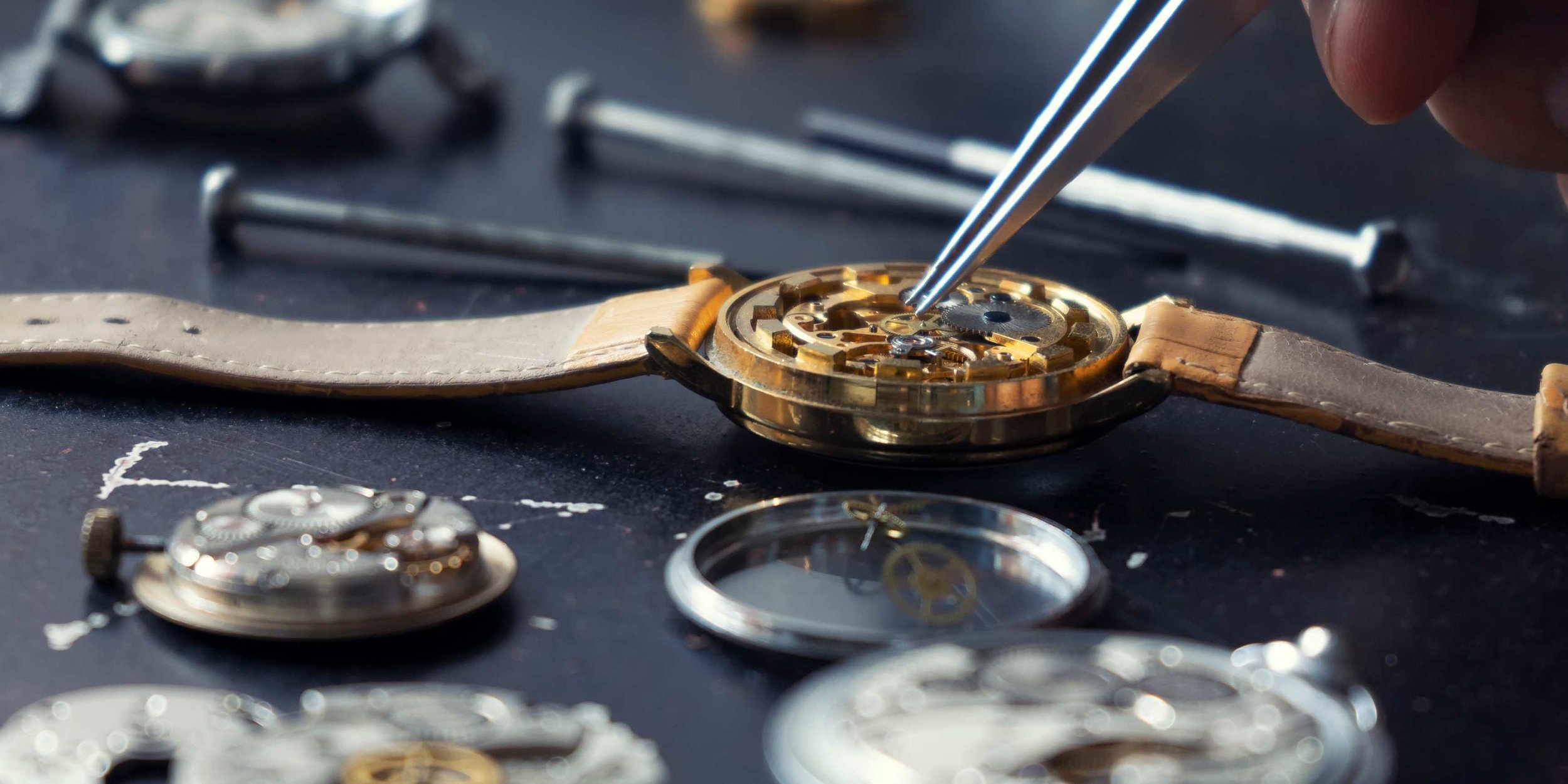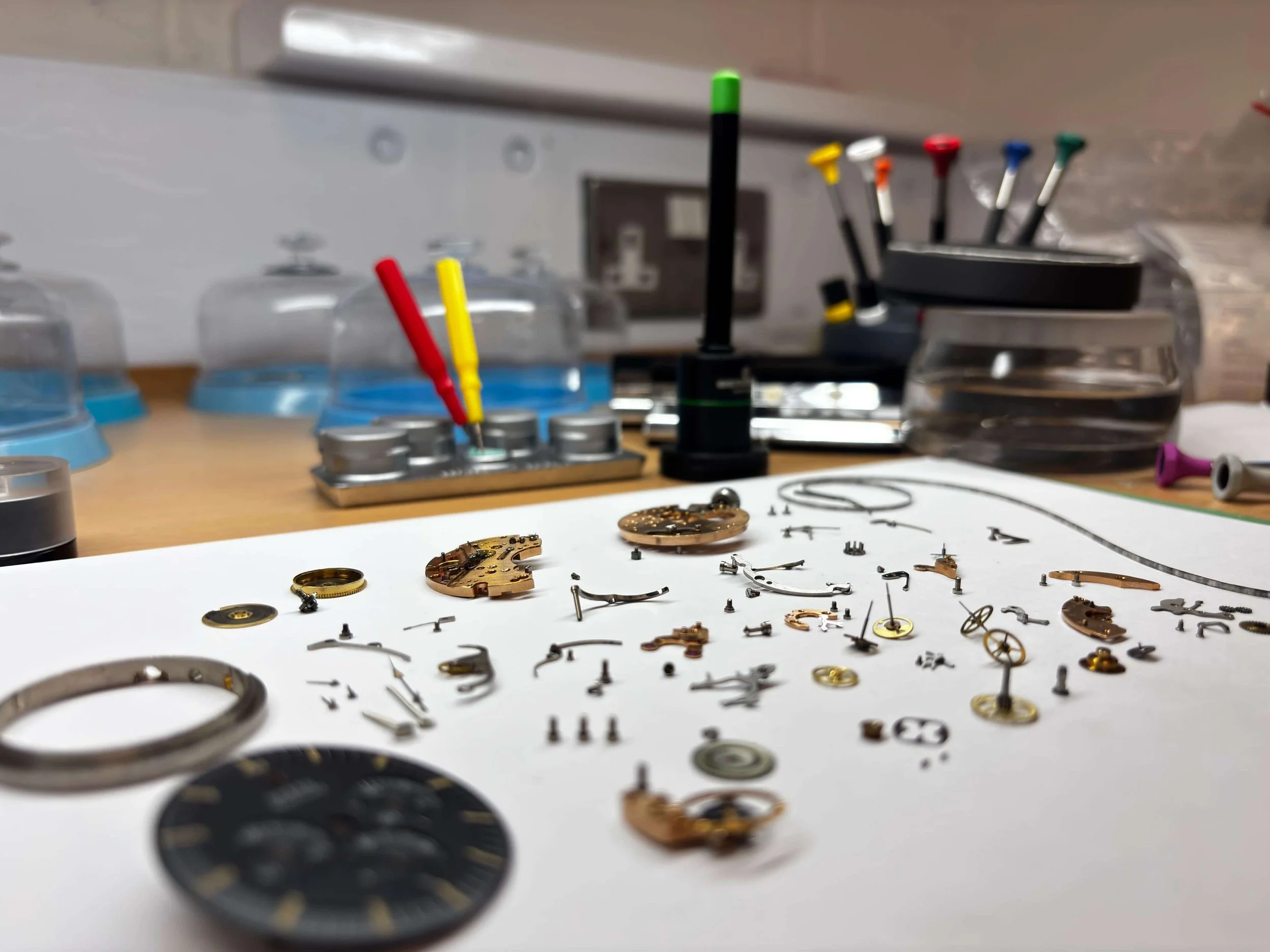What to Expect When Servicing Your Watch (Step-by-Step)
Handing over a watch—whether it’s a Rolex Submariner or your grandfather’s vintage Omega—to be serviced can feel daunting. People often worry: Will it be safe in transit? Will they swap out parts without asking? How long will I be without it? What will it cost? These concerns are valid. Watches carry financial and sentimental weight.
This guide walks you step by step through the entire watch service journey: from intake, diagnosis and quoting, through the bench work, testing, and finally back onto your wrist. Along the way, we’ll show you what “good” looks like—clear quotes, genuine parts, old parts returned in a bag, pressure-test slips, and timing results you can see.
By the end of this guide, you’ll know exactly what to expect—and why a well-executed service keeps your watch both reliable and valuable for years to come.
Watch Servicing vs Watch Repair
Many customers ask us: What’s the difference between a repair and a service, and do I really need both? It’s an important distinction.
Having your watch repaired is reactive – fixing a fault once something has already gone wrong. While a watch service, on the other hand, is preventative, it keeps your watch running smoothly and reduces the risk of costly failures later on.
Think of it like owning a car: you wouldn’t wait for the engine to seize before changing the oil. In the same way, a routine watch service refreshes lubricants, replaces worn seals, and checks accuracy so the movement continues to perform as it did when it left the factory.
Below, we've provided an example of how the two often overlap.
Case Study: The Rolex Submariner That Couldn’t Miss a Flight
A customer rushed in with his Rolex Submariner, concerned because it had stopped just weeks before his holiday to the Caribbean.
On inspection, we found the mainspring had snapped – the direct cause of the stoppage. But once the movement was open, it was clear there were deeper issues: the oils had dried, the gears were showing signs of wear, and the gaskets protecting its water resistance had become brittle.
With his trip looming, we recommended that he have his Rolex watch serviced, which included cleaning, re-oiling, regulation, and replacement of the gaskets. He agreed, knowing it would give him peace of mind in the pool and sea.
In the end, we didn’t just replace the broken mainspring – the service stopped further wear on the movement and restored the watch’s water-resistant capabilities. Even a trace of seawater could have caused catastrophic damage and repairs costing thousands.
Signs Your Watch Needs Servicing
In the world of horology, minor faults rarely stay minor. Without regular servicing, your wristwatch will almost certainly need attention for a range of common watch faults over its lifetime.
Early Warning Signs Your Watch Needs a Service
A watch in need of service often provides subtle hints before it stops altogether. Common warning signs include:
Time drift: gaining or losing more than a few seconds a day (mechanical) or minutes a month (quartz).
Fogging under the crystal: a common sign of moisture infiltrating your watch due to weakened seals.
Shortened power reserve: an automatic watch that once ran two days now stops overnight.
Grinding or stiff winding – resistance when winding the crown, or a rotor that feels rough when shaken.
These issues often stem from dried lubricants, natural wear, or seals that require replacement.
Risks of delaying a watch service
It’s easy to think, “I’ll wait until it stops,” but that approach often backfires.
A little moisture can rust a movement in just weeks.
Dry pivots and wheels that could have been saved with fresh oil may end up needing complete replacement.
Corrosion or quick-fixes can lead to lost originality – and a sharp drop in value.
Pro Tip: Having your watch serviced every 2–4 years typically prevents unexpected and costly repairs.
The Complete Process of Watch Servicing (Step-by-Step)
Having your watch serviced is a careful, step-by-step process that protects its originality, restores its accuracy, and ensures it leaves the bench performing just as it did when new. Here’s what that involves:
Step 1: Disassembly & Ultrasonic Cleaning
How Watchmakers Strip Down and Ultrasonically Clean Every Component
Your watch's movement is completely dismantled—hundreds of tiny parts laid out in order. Each component is inspected and cleaned in an ultrasonic cleaner that generates high-frequency sound waves, causing the cleaning solution to vibrate rapidly, which creates millions of tiny bubbles that implode upon contact with the watch components, gently lifting dirt and grime away from the surface.
Cleanliness is the foundation of reliability — even the slightest trace of residue can shorten the life of a service.
Step 2: Precision Lubrication of the Movement
Why Correct Oils and Application Are Critical in Watch Servicing
After ultrasonic cleaning, every component of your watch movement is dried and lubricated with the manufacturer’s specified oils. Each oil has a defined viscosity and is applied only where intended: high-friction contact points such as the escapement require heavier lubricants, while low-friction pivots like the balance wheel use finer grades. The volume of oil applied is equally critical—excess can migrate onto adjacent parts or escape the jewel, while insufficient lubrication leaves surfaces exposed to direct wear. Precision is everything; incorrect oiling can accelerate wear, impair timekeeping accuracy, and ultimately lead to premature failure of the movement.
Step 3: Genuine Parts Replacement
Why Only Authentic Watch Parts (or Vintage Equivalents) Should Be Used
Over time, mechanical watch components can degrade due to metal fatigue, frictional wear, or environmental stresses such as moisture, dust, or magnetic fields.
When parts need replacing, only genuine manufacturer components—or period-correct vintage equivalents—should ever be used. Designed to exact tolerances for each calibre, they ensure gears mesh smoothly, jewels seat correctly, and performance remains stable over time. By contrast, non-genuine parts may look the same but are often cut from inferior alloys with poor precision. The result? Faster wear, compromised accuracy, and, in some cases, permanent damage to the movement.
When it comes to choosing a watch repair specialist, they should always be transparent and clearly explain which parts must be replaced, which are optional, and the costs involved. Your old components should be returned to you, so you know exactly what was changed.
Step 4: Reassembly & Adjustment
How a Watch Movement Is Rebuilt, Realigned, and Prepared for Use
After cleaning and lubrication, the movement is reassembled with each gear, spring, and pivot precisely aligned to factory tolerances. Even the slightest misalignment can increase friction and disrupt efficiency, ultimately leading to poor accuracy or failure. Once the movement is reassembled, the dial, hands, crown, and other external components are refitted with equal care to ensure proper function and a secure case seal.
Step 5: Water Resistance & Pressure Testing
How Gaskets Are Replaced and Watches Are Certified Water-Resistant
If your watch is water-resistant, the gaskets (seals around the case back, crown, and crystal) are inspected and usually replaced during servicing. These seals prevent water, dust, and moisture from entering the case but degrade over time. After replacement, the watch is sealed and pressure-tested in a specialised chamber that simulates underwater conditions.
Passing the test confirms the gaskets are secure and your watch remains water-resistant to its rated depth—vital for preventing water damage to the movement and dial.
Pro Tip: Ask to see a pressure-test slip—it’s proof your watch was actually tested.
Step 6: Final Regulation & Quality Control
The Accuracy, Power Reserve, and Shock Tests Every Watch Must Pass
Once reassembled, every watch undergoes a series of tests to confirm it performs under real-world conditions.
Timekeeping accuracy – measured over 24 hours to ensure precision within industry standards.
Power reserve – verifies the watch holds charge as specified after a full wind.
Shock resistance – simulates everyday knocks to confirm durability.
Anti-magnetism – checks performance after exposure to strong magnetic fields.
Only when a timepiece passes each of these checks is it approved and returned to the customer.
Common Mistake: Believing a “24-hour overhaul” claim. Attention to detail is everything. A professional watch service should be carried out over a period of weeks to properly strip, rebuild, lubricate, and test the watch.
Why Watch Servicing Turnaround Times and Costs Vary
Not all watch services are created equal—and neither are the prices. What you’ll pay (and how long you’ll wait) comes down to the type of watch and the complexity of the movement.
A quartz movement is relatively simple, with only a dozen or so main components. In contrast, having your mechanical watch serviced involves the complete disassembly and ultrasonic cleaning of a movement containing 130+ engineered parts. Each wheel, pivot, and jewel is examined under magnification for wear, with tolerances measured in microns. The sheer number of parts, the precision required, and the time it takes to reassemble, lubricate, regulate, and test the watch all contribute to the higher cost and longer turnaround.
In short: servicing prices reflect far more than labour—they reflect the skill, time needed to restore your watch to factory performance.
Trade-offs & Preferences
Not all service decisions are black and white. Some choices affect value, originality, or even warranty. This section helps you weigh the trade-offs so you can decide what matters most to you.
Polishing vs Preserving Originality (vintage considerations)
As an optional extra during a watch service, you can choose to have your watch polished for a like-new finish. However, over-polishing can soften case edges, thin lugs, or even remove hallmarks — particularly on vintage models.
Many collectors value light scratches and natural patina over a “too perfect” finish. A skilled watchmaker should always confirm your preference: leave the case unpolished to preserve originality, or carry out a careful refinishing that sharpens lines without erasing character.
Pro Tip: Always state your preference in writing (“no polishing unless agreed”) before handing over a vintage watch.
Common Mistake: Believing polishing is always included — or always beneficial. It’s not. Learn why in our ultimate guide to watch polishing.
Authorised vs Independent Watch Servicing
Both authorised brand centres and independent specialists offer valid routes for servicing your watch — the best choice depends on your priorities.
Authorised service centres provide brand-backed records, warranty stamps, and guaranteed genuine parts, though often at higher cost and with longer turnaround times.
Independent watchmakers can match quality, source genuine parts (where available), and often take a more flexible or conservation-led approach, usually at a lower cost.
For newer watches still under warranty, authorised servicing may give extra peace of mind. For older or vintage pieces, an independent with the credentials can be a better option to preserve originality.
Common Mistake: Treating cost as the only factor. Always check the watchmaker’s parts policy, credentials, and approach — aftermarket seals or dials may save money upfront, but can sink long-term value.
Further reading: For a deeper look at how accredited centres compare with independents, see our guide on accredited vs independent watch repair centres.
Watch Service Safety & Logistics (Walk-in or Mail-in UK)
A watch isn’t just valuable in monetary terms—it often carries deep sentimental weight. Knowing it’s safe from the moment you hand it over until it comes back is just as important as the repair itself.
Intake photos, serial number checks & safe storage
At drop-off or arrival by post, a reputable repairer will photograph the watch, note its condition, and log the serial number, creating a clear record that ensures nothing is mixed up or disputed later. Once checked in, the watch should be stored in a safe or vault, handled only with gloves and protective tools.
Pro Tip: Always ask for a receipt or intake note with the serial number and visible condition recorded.
Common Mistake: Sending a watch without proof of intake—if something happens in transit, you’ll have no record of its condition.
Insured, trackable watch shipping & service updates
If you can’t walk in, an insured and trackable mail-in service is essential. For most UK repairs, expect £10–£30 extra for full insurance—a small price to safeguard a watch worth thousands.
Packaging should be padded, discreet, and require a signature on delivery. Once received, a confirmation email or call reassures you that it’s in safe hands. A named contact who gives updates during the process removes the stress of wondering if your watch has been “forgotten”.
Pro Tip: Always declare the full value of the watch for insurance, even if it raises the coverage cost.
Common Mistake: Posting a high-value watch with no insurance or tracking—loss or theft is not uncommon, and recovery without proof is near impossible.
Key Watch Service Takeaways
What this covers and why it matters: After a long guide, it helps to condense the essentials into a quick-reference list.
Watch for warning signs — time drift, fogging, grinding, or short power reserve mean it’s time for service.
A proper service involves a thorough strip-down, ultrasonic cleaning, the use of genuine parts, regulation, resealing, and thorough testing.
Expect realistic timelines — days for minor fixes, 2–4 weeks for complete services, longer if parts are rare.
Preserve what matters — polishing is optional; originality and authenticity should always be respected.
Safety is non-negotiable — insured, trackable shipping, intake photos, and secure storage ensure your watch is protected.
Proof builds trust — pressure-test results, old parts returned, and a written warranty show the job was done right.
Choosing a Trusted UK Watch Repairer
A well-serviced watch isn’t just cleaner or shinier; it’s safeguarded for years of reliable use. From the first intake photo to the final timing slip, every step of a proper service is designed to protect both the function and the story of your watch. Whether you own a daily quartz, a diver’s tool, or a vintage heirloom, the process should always feel transparent, careful, and respectful of your preferences.
By now, you know what “good” looks like: safe handling, clear quotes, genuine parts, tested accuracy, resealed cases, and written warranties. With that knowledge, you can approach your next service with confidence—asking the right questions, setting the right expectations, and choosing a repairer who treats your watch with the same care you do.
FAQs: Watch Servicing in the UK
How long does a complete watch service take?
Typically, 2–5 weeks with an independent watchmaker, like ourselves, or 6–8 weeks through an official brand centre. Complex or vintage jobs may take longer if parts need sourcing.
Will my watch be water-resistant after servicing?
Yes—if seals are replaced and the case passes a pressure test. For old vintage models, complete water resistance may no longer be possible, and a good watchmaker will explain the limits.
Can I avoid polishing my watch?
Absolutely. Polishing is optional, and many collectors prefer to keep the original lines and patina. Always tell your watch repairer your preference before any work begins.



